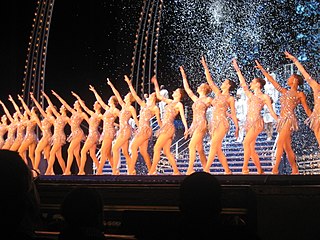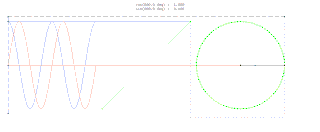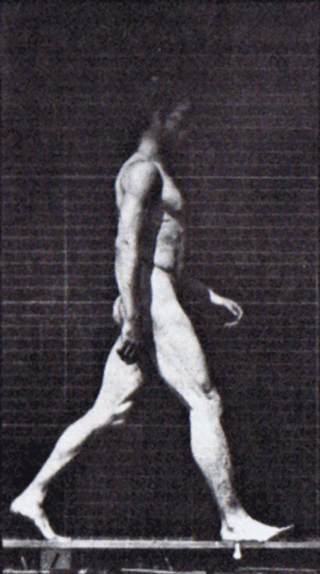
In physics, interference is a phenomenon in which two coherent waves are combined by adding their intensities or displacements with due consideration for their phase difference. The resultant wave may have greater intensity or lower amplitude if the two waves are in phase or out of phase, respectively. Interference effects can be observed with all types of waves, for example, light, radio, acoustic, surface water waves, gravity waves, or matter waves as well as in loudspeakers as electrical waves.

Synchronization is the coordination of events to operate a system in unison. For example, the conductor of an orchestra keeps the orchestra synchronized or in time. Systems that operate with all parts in synchrony are said to be synchronous or in sync—and those that are not are asynchronous.

A sine wave, sinusoidal wave, or sinusoid is a periodic wave whose waveform (shape) is the trigonometric sine function. In mechanics, as a linear motion over time, this is simple harmonic motion; as rotation, it corresponds to uniform circular motion. Sine waves occur often in physics, including wind waves, sound waves, and light waves, such as monochromatic radiation. In engineering, signal processing, and mathematics, Fourier analysis decomposes general functions into a sum of sine waves of various frequencies, relative phases, and magnitudes.
Muscle memory is a form of procedural memory that involves consolidating a specific motor task into memory through repetition, which has been used synonymously with motor learning. When a movement is repeated over time, the brain creates a long-term muscle memory for that task, eventually allowing it to be performed with little to no conscious effort. This process decreases the need for attention and creates maximum efficiency within the motor and memory systems. Muscle memory is found in many everyday activities that become automatic and improve with practice, such as riding bikes, driving motor vehicles, playing ball sports, typing on keyboards, entering PINs, playing musical instruments, poker, martial arts, swimming, dancing, and drawing.
Central pattern generators (CPGs) are self-organizing biological neural circuits that produce rhythmic outputs in the absence of rhythmic input. They are the source of the tightly-coupled patterns of neural activity that drive rhythmic and stereotyped motor behaviors like walking, swimming, breathing, or chewing. The ability to function without input from higher brain areas still requires modulatory inputs, and their outputs are not fixed. Flexibility in response to sensory input is a fundamental quality of CPG-driven behavior. To be classified as a rhythmic generator, a CPG requires:
- "two or more processes that interact such that each process sequentially increases and decreases, and
- that, as a result of this interaction, the system repeatedly returns to its starting condition."
In the field of computational neuroscience, the theory of metastability refers to the human brain's ability to integrate several functional parts and to produce neural oscillations in a cooperative and coordinated manner, providing the basis for conscious activity.
Motor control is the regulation of movements in organisms that possess a nervous system. Motor control includes conscious voluntary movements, subconscious muscle memory and involuntary reflexes, as well as instinctual taxis.

Neural oscillations, or brainwaves, are rhythmic or repetitive patterns of neural activity in the central nervous system. Neural tissue can generate oscillatory activity in many ways, driven either by mechanisms within individual neurons or by interactions between neurons. In individual neurons, oscillations can appear either as oscillations in membrane potential or as rhythmic patterns of action potentials, which then produce oscillatory activation of post-synaptic neurons. At the level of neural ensembles, synchronized activity of large numbers of neurons can give rise to macroscopic oscillations, which can be observed in an electroencephalogram. Oscillatory activity in groups of neurons generally arises from feedback connections between the neurons that result in the synchronization of their firing patterns. The interaction between neurons can give rise to oscillations at a different frequency than the firing frequency of individual neurons. A well-known example of macroscopic neural oscillations is alpha activity.
The Kuramoto model, first proposed by Yoshiki Kuramoto, is a mathematical model used in describing synchronization. More specifically, it is a model for the behavior of a large set of coupled oscillators. Its formulation was motivated by the behavior of systems of chemical and biological oscillators, and it has found widespread applications in areas such as neuroscience and oscillating flame dynamics. Kuramoto was quite surprised when the behavior of some physical systems, namely coupled arrays of Josephson junctions, followed his model.
J. A. Scott Kelso is an American neuroscientist, and Professor of Complex Systems and Brain Sciences, Professor of Psychology, Biological Sciences and Biomedical Science at Florida Atlantic University (FAU) in Boca Raton, Florida and The University of Ulster in Derry, N. Ireland.
In physiology, motor coordination is the orchestrated movement of multiple body parts as required to accomplish intended actions, like walking. This coordination is achieved by adjusting kinematic and kinetic parameters associated with each body part involved in the intended movement. The modifications of these parameters typically relies on sensory feedback from one or more sensory modalities, such as proprioception and vision.
Elliot SaltzmanArchived 2006-09-06 at the Wayback Machine is an American psychologist and speech scientist. He is a professor in the Department of Physical Therapy at Boston University and a Senior Scientist at Haskins Laboratories in New Haven, Connecticut. He is best known for his development, with J. A. Scott Kelso of "task dynamics ." He is also known for his contributions to the development of a gestural-computational model Archived 2006-12-08 at the Wayback Machine at Haskins Laboratories that combines task dynamics with articulatory phonology and articulatory synthesis. His research interests include application of theories and methods of nonlinear dynamics and complexity theory to understanding the dynamical and biological bases of sensorimotor coordination and control. He is the co-founder, with Philip Rubin, of the IS group.
Synchronization of chaos is a phenomenon that may occur when two or more dissipative chaotic systems are coupled.
The phi complex is a brain rhythm in the awake human brain that appears to serve various social functions. Phi is one of several brain rhythms in the awake human brain that coordinate human behavior. "Phi" operates in the 10-Hz band, and is located above the right centro-parietal cortex. It consists of two components, one favoring independent behaviors, and the other favoring interpersonal coordination between people.

Entrainment in the biomusicological sense refers to the synchronization of organisms to an external perceived rhythm such as human music and dance. Humans are the only species for which all individuals experience entrainment, although there are documented examples of entrained nonhuman individuals.
Homeokinetics is the study of self-organizing, complex systems. Standard physics studies systems at separate levels, such as atomic physics, nuclear physics, biophysics, social physics, and galactic physics. Homeokinetic physics studies the up-down processes that bind these levels. Tools such as mechanics, quantum field theory, and the laws of thermodynamics provide the key relationships. The subject, described as the physics and thermodynamics associated with the up down movement between levels of systems, originated in the late 1970s work of American physicists Harry Soodak and Arthur Iberall. Complex systems are universes, galaxies, social systems, people, or even those that seem as simple as gases. The basic premise is that the entire universe consists of atomistic-like units bound in interactive ensembles to form systems, level by level, in a nested hierarchy. Homeokinetics treats all complex systems on an equal footing, animate and inanimate, providing them with a common viewpoint. The complexity in studying how they work is reduced by the emergence of common languages in all complex systems.
The study of animal locomotion is a branch of biology that investigates and quantifies how animals move.

Interlimb coordination is the coordination of the left and right limbs. It could be classified into two types of action: bimanual coordination and hands or feet coordination. Such coordination involves various parts of the nervous system and requires a sensory feedback mechanism for the neural control of the limbs. A model can be used to visualize the basic features, the control centre of locomotor movements, and the neural control of interlimb coordination. This coordination mechanism can be altered and adapted for better performance during locomotion in adults and for the development of motor skills in infants. The adaptive feature of interlimb coordination can also be applied to the treatment for CNS damage from stroke and the Parkinson's disease in the future.

Heteroclinic channels are ensembles of trajectories that can connect saddle equilibrium points in phase space. Dynamical systems and their associated phase spaces can be used to describe natural phenomena in mathematical terms; heteroclinic channels, and the cycles that they produce, are features in phase space that can be designed to occupy specific locations in that space. Heteroclinic channels move trajectories from one equilibrium point to another. More formally, a heteroclinic channel is a region in phase space in which nearby trajectories are drawn closer and closer to one unique limiting trajectory, the heteroclinic orbit. Equilibria connected by heteroclinic trajectories form heteroclinic cycles and cycles can be connected to form heteroclinic networks. Heteroclinic cycles and networks naturally appear in a number of applications, such as fluid dynamics, population dynamics, and neural dynamics. In addition, dynamical systems are often used as methods for robotic control. In particular, for robotic control, the equilibrium points can correspond to robotic states, and the heteroclinic channels can provide smooth methods for switching from state to state.







